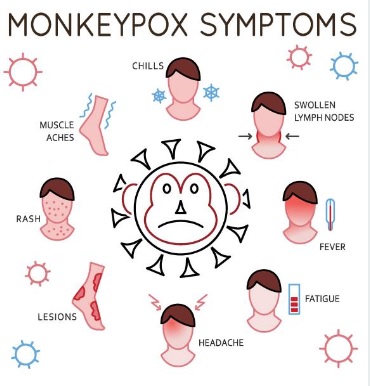Dec 25, 2025
Dec 25, 2025
So, it entered India too: the first laboratory-confirmed case of monkeypox virus was reported from a 35-year-old man, who recently arrived in Kerala’s capital, Thiruvananthapuram. Press reports indicate that it was an easy identification for the health department since the visitor said about his close contact with an infected man in UAE.
 Monkeypox virus infection causes a rare disease called monkeypox. Monkeypox virus belongs to the genus Orthopoxvirus and family Poxviridae. The genus Orthopoxvirus also includes variola virus, which causes smallpox and vaccinia virus which was used in the manufacture of the smallpox vaccine, and cowpox virus.
Monkeypox virus infection causes a rare disease called monkeypox. Monkeypox virus belongs to the genus Orthopoxvirus and family Poxviridae. The genus Orthopoxvirus also includes variola virus, which causes smallpox and vaccinia virus which was used in the manufacture of the smallpox vaccine, and cowpox virus.
It was first reported in monkeys maintained in a laboratory for research in 1958. The first human infection of it was reported in 1970 when a nine-month-old child from the Democratic Republic of Congo, was infected. Nigeria too reported a monkeypox infection in humans in 1970 and two more in 1978.
For almost four decades thereafter, there was no reporting of monkeypox. But in 2017 it re-emerged in Nigeria. Between September 2017 and April 30, 2022, it has reported 558 cases. Among them, 231 have been confirmed by laboratory tests. Since then, dozens of cases were reported from Nigeria year after year.
Based on the clinical examination of confirmed cases from Nigeria during 2017-2018, researchers have found that the virus transmits primarily from an infected animal or from an infected person. Transmission from animal to man occurs through broken skin or through direct contact with an infected animal’s blood, bodily fluids, or pox lesions. Man to man transmission occurs when one comes in contact with the sores, sobs, respiratory droplets, or oral fluids of an infected person. One may even pick it up by coming into contact with recently contaminated clothing, bedding, and other clothes used by an infected person.
Bill Hanage, Associate Professor of epidemiology from Harvard TH Chan School of Public Health, commented that many early cases were noticed among gay or bisexual men, and people with multiple sexual partners. There is however no evidence to indicate that the virus transmits through semen or vaginal fluids. It is believed that it is the skin-to-skin contact during sex that might have resulted in the virus spread.
 Epidemiologists say that it may take several days to a few weeks for an infected person to develop symptoms. Early signs of infection may look like flu-like symptoms: fever, chills, headache, muscle aches, fatigue, and swollen lymph nodes. After a few days, a rash often develops. Rash may start as flat, red bumps and they may be painful. Later, these bumps may turn into blisters that fill with pus. Over a period of two to four weeks, the blisters may crust over and fall off. One may also get sores in the mouth, vagina, or anus.
Epidemiologists say that it may take several days to a few weeks for an infected person to develop symptoms. Early signs of infection may look like flu-like symptoms: fever, chills, headache, muscle aches, fatigue, and swollen lymph nodes. After a few days, a rash often develops. Rash may start as flat, red bumps and they may be painful. Later, these bumps may turn into blisters that fill with pus. Over a period of two to four weeks, the blisters may crust over and fall off. One may also get sores in the mouth, vagina, or anus.
In the current outbreak of the disease, it is noticed that all the infected persons need not necessarily develop all these symptoms. Some may have relatively few blisters than what is normally expected. With the result, there is a likelihood of misdiagnosing it as other infectious diseases. Here the danger is the infected man though not showing any symptoms could still transmit the virus to others. But the rate of spread of the disease by an infected person is still not known.
But what is most intriguing about this disease is that while the monkeypox outbreak was noticed in Nigeria as early as 2017 and subsequently dozens of cases were reported from time to time in African countries, no international attempt was made to stop the outbreak in Nigeria, nor did any agency paid requisite attention to research the disease till its latest outbreak in Europe and North America. Even to date, the host animal of the virus that acts as its reservoir is not known. In the light of this, African scientists’ accusation that till wealthy countries are affected by the disease, no one had paid attention to study the disease and its spread sounds true.
For, it was only after the disease was spread to Europe – the first case of the virus outside Africa was reported from the UK on May 6th, 2022 and since then it spread to over 60 countries –that the researchers from Portugal uploaded the first draft genome of the monkeypox virus detected in the country. Based on the preliminary genetic data, researchers said that the virus found in Portugal is related to a viral clad that was predominantly found in West Africa, which was found to cause milder disease with a lower death rate of 1% in rural population. However, Gustavo Palacios, a virologist from the Icahn School of Medicine at Mount Sinai, said that more work needs to be done to draw definitive conclusions about the disease.
Of course, it is still not known for certain if this is the same strain that is causing concern across England and North America. True, currently genome sequencing is being carried out actively, and till date 15 genomes are reported to have been sequenced. And theoretically. this being a DNA virus, mutation rate would not be as alarming as in the case of RNA-virus. However, nothing is still known about its mutation rate for certain. So, what is needed is more research to know about its source animal and also the reasons for its current rapid spread in the hitherto non-endemic countries.
Despite the fact that the current spread of the monkeypox disease is commented by virologists as an “eye-opening” kind, scientists believe that it would fizzle out on its own: it will not spread that easily between people and there is a vaccine to prevent it and it is easily noticed when somebody’s got it. They say it would not certainly become a pandemic. Joining them in that hope, let us keep ourselves well informed of the latest findings about the disease so as to stop its spread.
That said, we must also remember that once a new disease is noticed—be it in Africa or elsewhere—threatening mankind, it is incumbent upon the rich nations to show solidarity by undertaking requisite research for its control. For, it is a matter of a few months for a new disease to spread to the rest of the world from its place of origin ...
16-Jul-2022
More by : Gollamudi Radha Krishna Murty